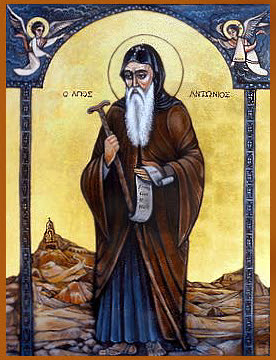In his colorful and much too short account of the great desert saint and father of monasticism, St. Athanasius describes the last moments of St. Anthony's life:
Having said this, when they had kissed him, he lifted up his feet, and as though he saw friends coming to him and was glad because o them--for as he lay his countenance appeared joyful--he died and was gathered to the fathers. And they afterward, according to his commandment, wrapped him up and buried him, hiding his body underground. And no one knows to this day where it was buried, save those two only. But each of those who received the sheepskin of the blessed Antony and the garment worn by him guards it as a precious treasure. For even to look on them is as it were to behold Antony; and he who is clothed in them seems with joy to bear his admonitions."
St. Anthony has been the inspiration of many, and we are especially fascinated by the artwork throughout the ages that depicts various moments in his life. Artists seem to be especially interested in his battles with demons (and understandably so). Here are just a few of the paintings of these momentous desert battles, from Michelangelo to Dali:
 | ||||
| "The Torment of Saint Anthony"--and Michelangelo's oldest known painting, c. 1487-1488 |
 | |
| "Temptations of St. Anthony" by Bernadino Parenzano, c. 1494 |
 | |||||
| "The Temptation of St. Anthony"; Jacopo Tintoretto; c. 1577 |
 | ||
| "The Temptation of St. Anthony"; Paul Cezanne; 1875 |
 | ||
| "The Temptation of St. Anthony"; Salvador Dali; c. 1946 |
And it appears that these epic encounters are also inspiring to cooks. In Spain, it is the tradition to cook "Olla de San Anton," a soup that uses virtually every part of a pig that is available in butcher shops, including the blood. This tradition is based on the legend that the devil often appeared to St. Anthony in the form of a pig. Here's a traditional recipe we would like to make some day, when blood sausage is as common as it should be in American meat markets and grocery stores. Forgive the awkward translation; its from a Spanish site:
Ingredients:
- 1/2 Kg of dry broad-bean

- 200 g of white beans
- 1 onion
- 1 sweet pepper
- 1 garlic
- 1 bone of marrow
- 1 bone of ham
- 200 g of pork ribs
- 200 g of fat streaky bacon
- 1 pork ear
- 1 pork tail
- 1 thyme branch
- 2 fennel leaf
- 2 rice glass
- 3 potatoes
- salt
- blood sausage
Soak the broad-beans and the beans the day before.
Peel the onion and cut it in two parts, wash the bones of marrow and ham, and put the ingredients (except the bloody sausage, the rice, and the potatoes), in a pot full of water. Let it cook slowly for one hour and half.
During this time, peal the potatoes and cut it in pieces, drop it in the pot with the rice and the bloody sausage.
Let cook twenty minutes more and serve it hot.
For those of us who don't have easy access to pig ears, feet and blood, here's a tamer recipe that we make from the book Monastery Soups. The original recipe is vegetarian, but we like to add pork sausage or chorizo on this particular feast day.
INGREDIENTS:
3 tablespoons oil of choice
1 cup barley
1 carrot, finely grated
2 leeks, sliced
1 bay leaf
1/3 cup fresh parsley, minced
salt to taste
7 cups water
1 bouillon cube (or you can use broth in place of the water)
chopped mushrooms
1 pound pork sausage or chorizo
3 tablespoons oil of choice
1 cup barley
1 carrot, finely grated
2 leeks, sliced
1 bay leaf
1/3 cup fresh parsley, minced
salt to taste
7 cups water
1 bouillon cube (or you can use broth in place of the water)
chopped mushrooms
1 pound pork sausage or chorizo
DIRECTIONS:
1. Heat the oil in a soup pot and add the barley, stirring continuously for one minute. Immediately add the carrot, leeks, bay leaf, parsley, salt, and water.
2. Cook the sausage in a separate skillet and add to the soup.
3. Cook the soup over low to medium heat, covered, for 40 to 45 minutes, until the barley is tender. Add more water if needed. For extra taste, add the bouillon and the mushrooms during the last 20 minutes of simmering. Remove the bay leaf. Serve hot.
St. Anthony the Great, Pray for Us!

Anything + pork sausage or chorizo = festivity
ReplyDeleteI love your post on St. Anthony of the Dessert. He is indeed a fascinating saint! I painted a portrait of him, which you can view at http://peterblochart.com/archives/219
ReplyDeleteI hope you enjoy!
-Peter Bloch
Catholic Artist in Phoenix
Visit my blog: www.adraughtofvintage.com
Visit my artist website: www.peterblochart.com